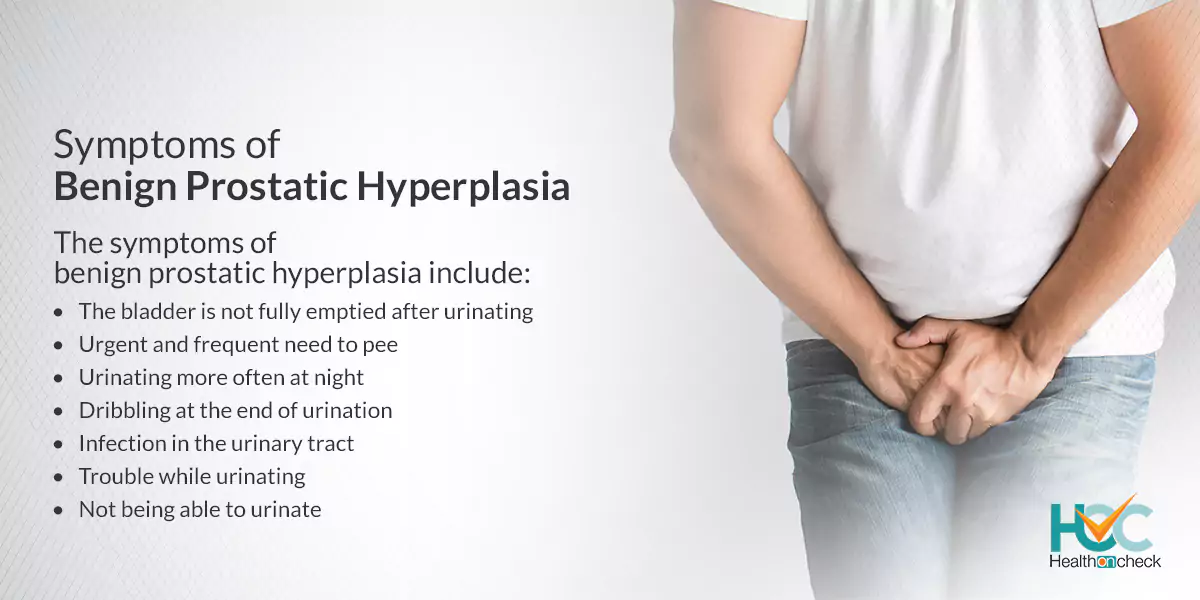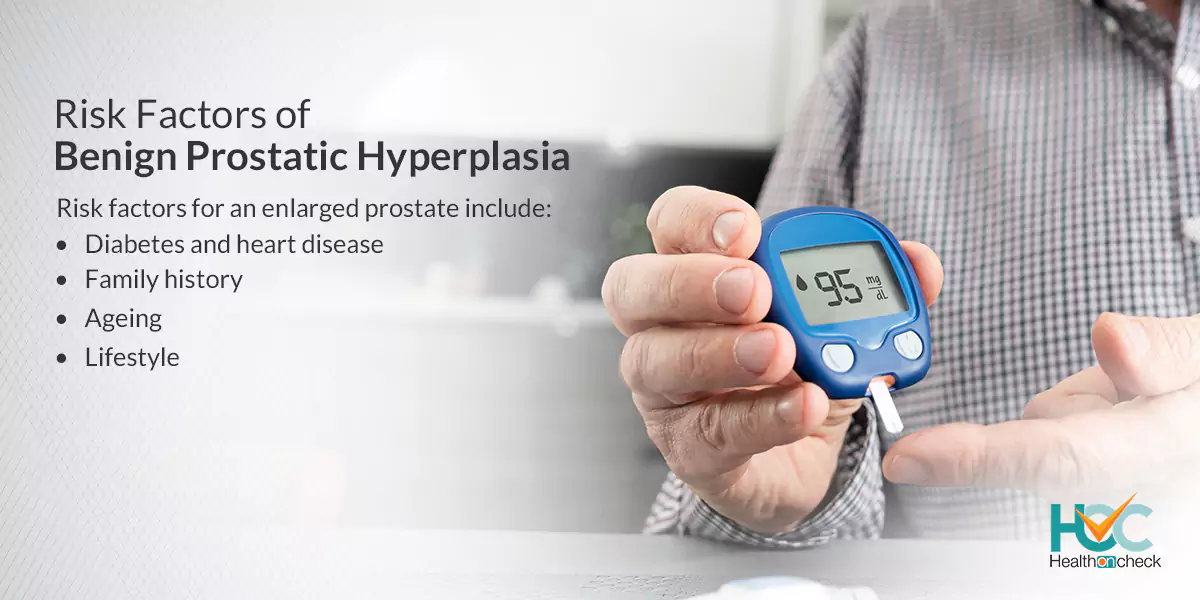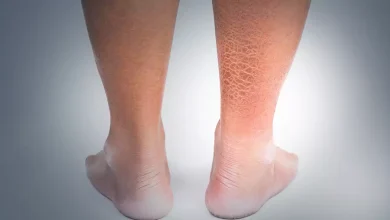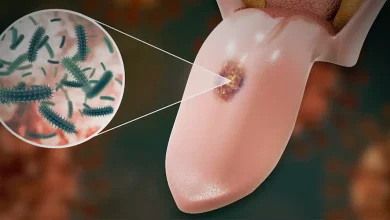What is Benign Prostatic Hyperplasia?

Benign prostatic hyperplasia is a health condition where your prostate increases in size. The prostate is a gland that is placed below your bladder and in front of your rectum. Its size is about a walnut, and your urethra is surrounded by it. The urethra is a tube carrying urine (pee) and sperm (ejaculate) out of your body. When your prostate increases in size, it might stop urination and ejaculation from passing via your urethra. Benign prostatic hyperplasia isn’t cancerous but its symptoms might indicate more serious conditions, such as prostate cancer.
What are the Symptoms of Benign Prostatic Hyperplasia?
The symptoms of benign prostatic hyperplasia include:
– Urgent and frequent need to pee
– Urinating more often at night
– Trouble while urinating
– A pee stream that stops and starts or a weak urine stream
– Dribbling at the end of urination
– The bladder is not fully emptied after urinating.
– Infection in the urinary tract
– Not being able to urinate
– Blood in the urine.
What are the Causes of Benign Prostatic Hyperplasia?
The prostate gland is placed underneath the bladder. The tube that passes urine from the bladder out of the penis is known as urethra. This tube passes through the center of the prostate and when the prostate grows in size, it begins to block urine flow. The prostate is a gland that generally keeps growing all through your life and this growth sometimes enlarges the prostate enough to block urine flow. The cause behind the prostate’s growth in size is not yet clear but it may be because of changes in the balance of sex hormones when people grow older.
What are the Risk Factors of Benign Prostatic Hyperplasia?
Risk factors for an enlarged prostate include:
– Ageing
The symptoms of an enlarged prostate rarely occur before age 40. After that, the risk of having an enlarged prostate and its symptoms begins to appear.
– Family history
If you have a blood relative with prostate problems then your risk of having problems with your prostate increases.
– Diabetes and heart disease
Studies have shown that diabetes and heart disease might increase the risk of benign prostatic hyperplasia.
– Lifestyle
Obese people are quite prone to benign prostatic hyperplasia and exercise lowers its risk.
What are the Complications of Benign Prostatic Hyperplasia?
Complications of benign prostatic hyperplasia include:
– Not being able to urinate
This problem is also known as urinary retention. If you get this problem then a tube known as a catheter is placed into your bladder to drain the urine. Some people with an enlarged prostate might require surgery to urinate properly.
– Urinary tract infections (UTIs)
If the bladder is not fully emptied the risk of infection in the urinary tract increases. If you get UTIs most often then surgery might be needed to remove part of the prostate.
– Bladder stones
Being unable to fully empty the bladder might lead to bladder stones which can cause illness, blood in the urine, bladder irritation, and blocked urine flow.
– Damaged bladder
If your bladder is not empty fully then it stretches and weakens over a period, which can cause the muscular wall of the bladder to no longer be able to squeeze properly to get urine out. It makes it harder to fully empty the bladder.
– Kidney damage
Pressure in the bladder due to not being able to urinate might damage the kidneys or let bladder infections reach the kidneys.
How Benign Prostatic Hyperplasia is Diagnosed?
Your doctor is likely to start the diagnosis by asking questions about your symptoms. After that, there will be a physical exam that includes:
– Digital rectal exam
Here your doctor will insert a finger into your rectum to examine if your prostate is enlarged.
– Urine test
A sample of your urine is sent to the lab to check if you have an illness or other problems that can lead to the same symptoms of benign prostatic hyperplasia.
– Blood test
It helps to diagnose if you have kidney problems.
After these procedures, you may require other tests to confirm an enlarged prostate. These tests usually include:
– Prostate-specific antigen (PSA) blood test
Prostate-specific antigen is a protein produced in the prostate. The levels of PSA go up after the prostate is enlarged. But higher PSA levels also can be because of recent treatments, illnesses, any kind of surgery, or prostate cancer.
– Urinary flow test
Here you need to urinate in a container connected to a machine that measures how strong your urine flow is and how much urine you have passed. The results of this test show whether your condition is improving or getting worse.
– Postvoid residual volume test
It measures whether you have the ability to fully empty your bladder while urinating. The test is done using an imaging exam known as ultrasound or with a tube known as a catheter attached to your bladder after you urinate to measure how much urine you have left in the bladder.
– 24-hour voiding diary
It involves making notes of how often and how much you urinate. It can be quite helpful if you make above a third of your daily urine at night.
What are the Treatment Options Available for Benign Prostatic Hyperplasia?
If your symptoms are mild, you might not need any treatment but your doctor might recommend a “watchful waiting” approach in which you need to schedule frequent appointments to make sure your benign prostatic hyperplasia doesn’t get worse.
The treatment options for benign prostatic hyperplasia include:
– Medications
Medications are given to make muscle in your prostate relax, which decreases tension in your urethra. Common medicines given for BPH include:
– Tamsulosin
– Terazosin
– Doxazosin
– Alfuzosin
– Silodosin
Some medications reduce the production of the hormone DHT, which slows the growth process of your prostate gland. These medicines are most beneficial for people with bigger prostates. Examples of medicines include:
Finasteride
Dutasteride
Your doctor might also prescribe combined medications to treat your symptoms along with improving your urine flow. Dutasteride and tamsulosin are examples of such medicines.
After you start a medication, it may take between one and eight weeks for your symptoms to improve.
– Surgery
There are various types of surgeries available to remove prostate tissue that blocks your urethra including:
– Transurethral resection of the prostate (TURP)
Here your urologist will insert a special instrument (resectoscope) via your urethra that permits them to see and get rid of prostate tissue.
– Transurethral incision of the prostate (TUIP)
In this type of surgery, your urologist will create two small incisions in your prostate and the area where your urethra and bladder join (bladder neck) to make your urethra wide and improve the flow of urine.
– Transurethral electrovaporization
An electrode is used in this procedure to heat your prostate tissue. The tissue cells in the enlarged areas of your prostate turn into steam with this procedure.
– GreenLight laser
A special laser is used by your urologist to evaporate your enlarged prostate tissue.
After a surgical procedure, you can resume normal activities after some days or a week.
Minimally invasive treatments
New BPH treatments are less damaging and invasive to healthy tissue as compared to surgery. Usually, most of these treatments are outpatient procedures, after which you can go home the same day after the treatment. The advantages of these treatments are that they are cheaper with few side effects and recovery is faster. However, because these techniques are new, the information about their long-term effects or complications is limited.
Examples of minimally invasive treatments include:
– Prostatic urethral lift.
In this procedure, your enlarged prostate lobes are separated to make your urethra wider, which makes it easier for you to urinate. A special instrument (UroLift) is inserted into your urethra and up to your prostate. After the UroLift reaches the side wall of your prostate, small implants are ejected that pull your prostate lobes apart and your urethra is opened. Your urologist might attach two to six implants, based on the size of your prostate.
Water vapour therapy
Here an instrument is inserted into your urethra and your urologist then moves it to your prostate. He/she then ejects a needle into your prostate. Steam vapour is ejected by this needle, which turns the prostate into water. Your prostate cells are destroyed by the water’s thermal energy and your body reabsorbs the dead cells, making your prostate shrink. This procedure is also known as the Rezūm System.
The most common side effects of these treatments are urinating more than usual with some discomfort or irritation while your prostate is healing.
Post a minimally invasive procedure, you may be able to return to your normal activities in some days and your symptoms tend to improve within three to six weeks.
Living with Benign Prostatic Hyperplasia
Benign prostatic hyperplasia is a very common condition affecting the male population. It generally develops near the age of 50. In case you have mild benign prostatic hyperplasia, your doctor might monitor your symptoms through regular tests. If benign prostatic hyperplasia starts to affect the quality of life and daily activities, treatments are available to shrink your prostate.
Whom to Consult?
If you notice symptoms of BPH, you should discuss it with your doctor, even if they don’t bother you. It’s quite vital to determine if the symptoms can be treated because, without treatment, the risk of a dangerous blockage of the urinary tract can increase. If you are not able to pass any urine, you should get medical assistance as soon as possible because it can cause serious health complications.






